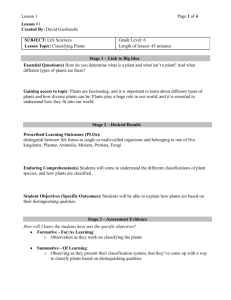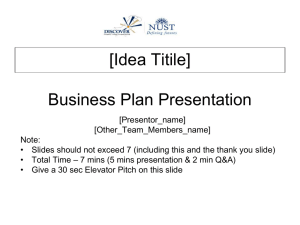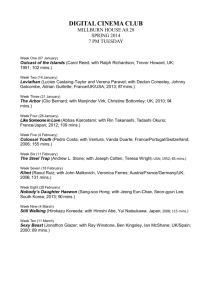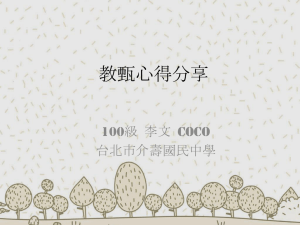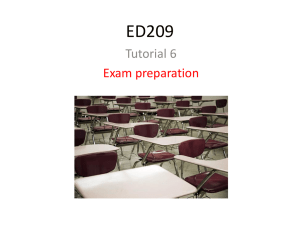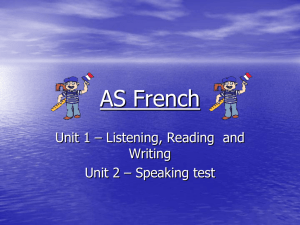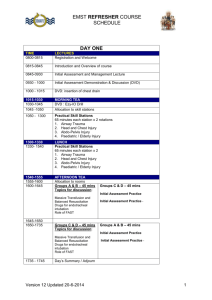Lesson Plan Template
advertisement
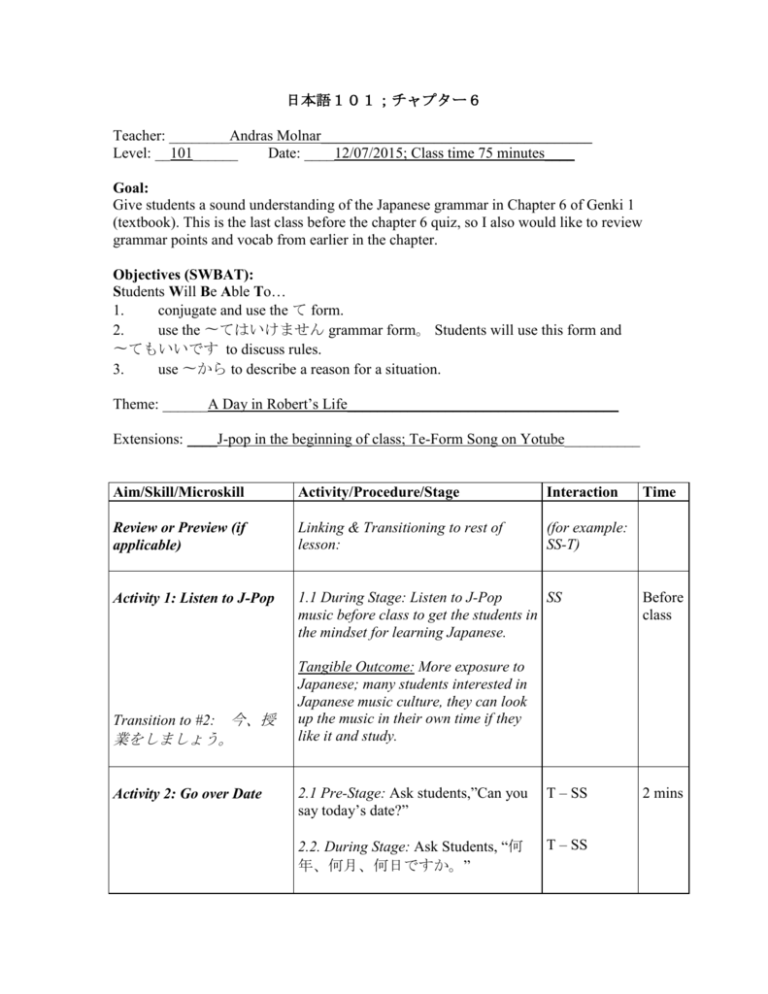
日本語101;チャプター6 Teacher: ________Andras Molnar____________________________________ Level: __101______ Date: ____12/07/2015; Class time 75 minutes____ Goal: Give students a sound understanding of the Japanese grammar in Chapter 6 of Genki 1 (textbook). This is the last class before the chapter 6 quiz, so I also would like to review grammar points and vocab from earlier in the chapter. Objectives (SWBAT): Students Will Be Able To… 1. conjugate and use the て form. 2. use the 〜てはいけません grammar form。 Students will use this form and 〜てもいいです to discuss rules. 3. use 〜から to describe a reason for a situation. Theme: ______A Day in Robert’s Life____________________________________ Extensions: ____J-pop in the beginning of class; Te-Form Song on Yotube__________ Aim/Skill/Microskill Activity/Procedure/Stage Interaction Review or Preview (if applicable) Linking & Transitioning to rest of lesson: (for example: SS-T) Activity 1: Listen to J-Pop 1.1 During Stage: Listen to J-Pop SS music before class to get the students in the mindset for learning Japanese. 今、授 業をしましょう。 Transition to #2: Activity 2: Go over Date Time Before class Tangible Outcome: More exposure to Japanese; many students interested in Japanese music culture, they can look up the music in their own time if they like it and study. 2.1 Pre-Stage: Ask students,”Can you say today’s date?” T – SS 2.2. During Stage: Ask Students, “何 年、何月、何日ですか。” T – SS 2 mins (Activity 2) 2.3 Post-Stage: Remember that dates 1 T-SS – 10 are special. Tangible Outcome & T. feedback/peer Transition to #3:Ok, now we feedback: Get students used to the will look at today’s lesson different ways of saying days of the week, and dates in Japanese. (2 mins) Activity 3: Go Over Today’s 3.1. During Stage: Give students a brief overview of the day’s lesson to Lesson Plan prime their expectations for the day’s class: Vocab Quiz 2 p 149 Exit Ticket Comments て Form Review V てはいけません ...から しゅくだい Transition to #4: ボキャブ ラリークイズをしましょ う。 Activity 4: Vocab Quiz Transition #5: 終わりまし たか。次は復習をしまし ょう Activity 5: Exit Ticket Discussion T-SS Tangible Outcome: SS will understand the objectives for the day’s lesson 2 mins (4 mins) 4.1 Pre-Stage: Say: 教科書を閉めて ください。(TAs help hand out quiz) T(TA)-SS 1 min 4.2. During Stage: Put the vocab quiz up on powerpoint (ppt) SS 5 mins 4.3 Post-Stage: Collect quiz T(TA) - SS 1 min Tangible Outcome & T. feedback/peer feedback: Check vocabulary knowledge of students; incentive to study vocab 5.1 Pre-Stage: Say, “Here are questions T-SS from last class. Think about these with people around you, and try to answer them. どうぞ.” (11 mins) 1 min (Activity 5) 5.2. During Stage: SS work together to SS-SS answer the questions. They can discuss them in English or Japanese. 4 mins 4 mins 5.3 Post-Stage: T will review answers. SS-T-SS Ask SS to share. Transition #6: (Question #4 about the て form) Now that you have thought about the て form, let’s see if you remember. Tangible Outcome & T. feedback/peer feedback: These questions in this segment are directly from the students. This activity allows students to feel like their concerns are being heard by the teacher, and simultaneously allows them to review (and remember) the previous class Activity 6: て Form Review; 6.1 Pre-Stage: Sing the て Form song; Describe Your Weekend review the う、る verb and irregular conjugations; listen to youtube clip of ss student singing て Form song 6.2. During Stage: Use the て form to describe your weekend/recent events. Use V1 て、V2 form (studied last class). Transition #7: 〜てはいけ ませんを勉強しましょ う。聞いてください。 (20 mins) T-SS 5 mins SS-SS 4 mins 6.3 Post-Stage: Review answers. Focus SS-T-SS on Question 4 because answers very variable and probably fun for class to hear. 3 mins 6.4 Post-Stage: Review/Summary Slide T-SS 1 min Tangible Outcome & T. feedback/peer feedback: SS Review て Form conjugation, and a gram. point from last class in an authentic, real-life activity. SS will work together, correct each other and help each other conjugate. Activity 7: 〜てはいけませ 7.1 Pre-Stage: Give examples of 〜て T-SS ん はいけません; things you cannot do in (33 mins) 2 mins (Activity 7) a restaurant. Let the students process the form; how it looks grammatically and for meaning. 7.2 Pre-Stage: Grammar explanation using pictures and examples 7.3. During Stage: Students do exercises from book (p 159, part A) T-SS 3 mins 5 mins SS-SS 7.4 Post-Stage: Check Answers 1 min SS-T-SS Transition: Now that we know how to say must not, let’s think about how to use this for making rules Activity 8: Rules for Class Tangible Outcome & T. feedback/peer feedback: TAs and T walks around the class during activity to give individual assistance during pair-work. SS should understand the meaning and conjugation of (44 mins) 8.1 Pre-Stage: Using 〜てはいけませ T-SS ん and もいいですか、give some examples of things you can and cannot do in class using picture prompts. 8.2. During Stage: Based on the prestage, have students think of rules for class on their own (at least 3 per gram point) SS-SS 8.3 Post-Stage: Listen to what SS have SS-T come up with. Share a few examples on ppt. Transition: Now we will cover our last grammar point for the semester! Activity 9: 〜から Tangible Outcome & T. feedback/peer feedback: SS work together to describe class rules. The answers are personal, thus they will be more meaningful. T/TA walk around and assist as necessary. 9.1 Pre-Stage: Give examples of 〜か ら using pictures. Let the students process the form; how it looks grammatically and for meaning. 2 mins 4 mins 2 mins (52 mins) T-SS 3 mins (Activity 9) Explain the grammar point using a simple example (今、勉強します。明 日、テストですから) 9.2. During Stage: SS complete p 161 together. T/TA walk around the room and provide feedback. Transition: We have finished all the grammar for Ch.6. も う一度、Dialogue を見ま しょう。146p を見てくだ さい。 Activity 10: Dialogue Review (IF TIME PERMITS) SS-SS 9.3 Post-Stage: T reviews answers with T-SS SS. 2 mins Tangible Outcome & T. feedback/peer feedback: This form is generally very straight forward, so students should understand easily. After exercise, SS should be able to understand and use 〜から to provide reasons. (62 mins) 10.1 Pre-Stage: Now that we have T-SS finished the chapter, let’s take a look at the dialogue again (p146). This contains all the grammar points, you should be able to read it. 1 min 10.2. During Stage: Read the dialogue on p 146 with your partner. 4 mins SS-SS 10.3 Post-Stage: Review together; read SS/T out loud if time. Transition: ちょっとだ け、漢字を勉強しましょ う Activity 11: Kanji Practice 5 mins Tangible Outcome & T. feedback/peer feedback: There may not be time to do this activity, but it give a good overview of the whole chapter. 3 mins (70 mins) 11.1 Pre-Stage: p 314 を見てくださ T-SS い。Let’s review Kanji one more time before the test. 1 min 11.2. During Stage: SS work on the map exercise (Part B) SS-SS 4 mins 11.3 Post-Stage: T asks for answers, provides answers on ppt. SS-T 1 mins (Activity 11) Wrap-up: Ok, let’s finish up class. Activity 12: HW and Exit Ticket Tangible Outcome & T. feedback/peer feedback: SS rarely get a chance to practice kanji, so I always do kanji practice at least once per class for repetition. This should give SS exposure to kanji. 12.1: T explains HW for next class T-SS 1 min 12.2: SS fill out exit tickets on their way out. They may leave when they have completed them. さようなら〜 SS Free Tangible Outcome: SS aware of HW ( and that there will be a test); T gets feedback from the class via Exit Ticket Wrap-up: Exit Ticket Class End Lesson Evaluation Procedures: see SS above. These will be used as review for next class. Materials: Genki 1 textbook; ppt print out. Anticipated Problems & Suggested Solutions: SS might not grasp the material, or still have problems with TE-form by the end of class. Have the students download the slides (http://hunterjapanese101.weebly.com/) and practice at home. Contingency Plans (what you will do if you finish early, etc.): There is an extra-time contingency plan worked into class (dialogue reading).

